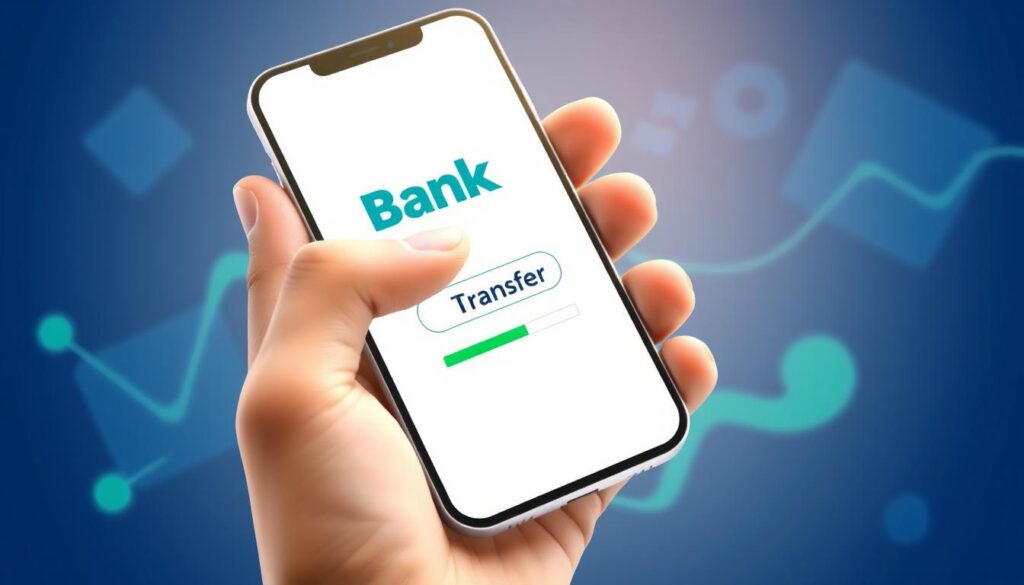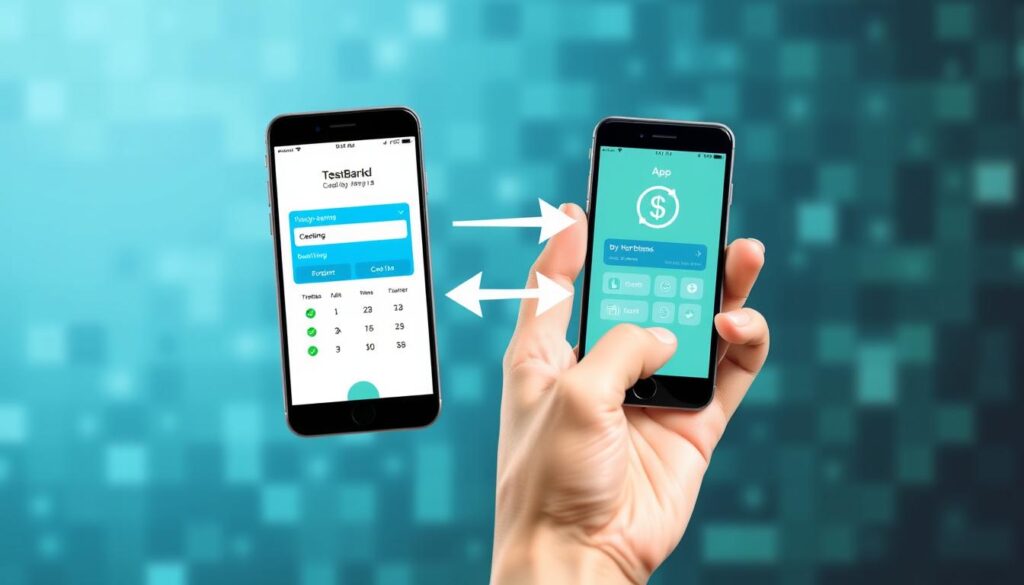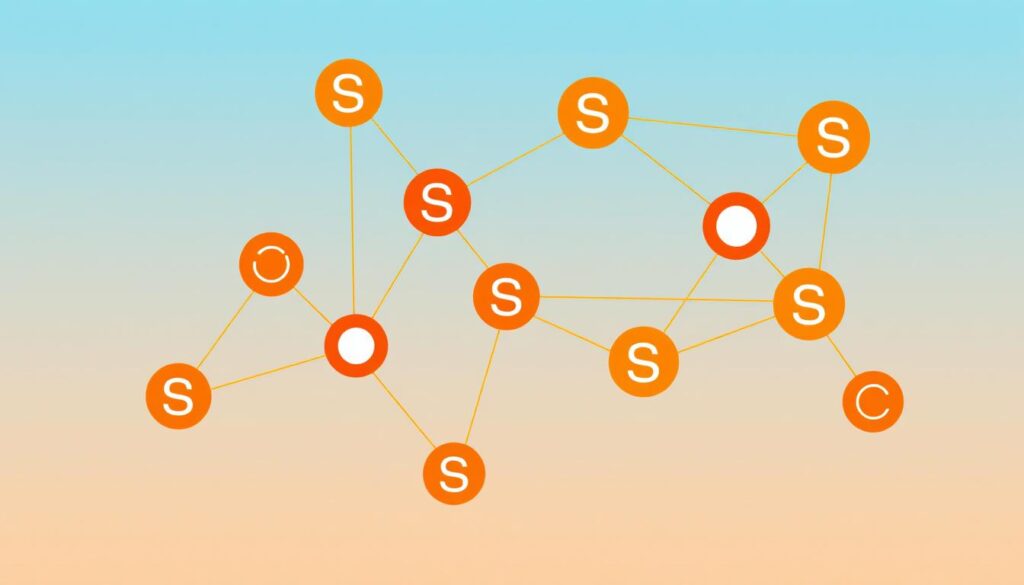Did you know online transfers between banks are usually free? But, some banks might charge a fee. It’s important to know how to move money between your digital bank accounts. This guide will show you how to do it easily for budgeting, saving, or sending money to others.
Nowadays, mobile banking and peer-to-peer apps change how we handle our money. With financial technology, you can easily move money between your digital accounts without extra fees. This guide will explain the main steps for online money transfers. It ensures your money moves are safe and quick.
Key Takeaways
- Online transfers between banks are generally free, although some banks may charge fees.
- Transfers usually take up to three business days to complete.
- Linking your digital bank accounts is the first step to facilitate easy fund transfers.
- Understanding transfer limits and fees is crucial to avoid unexpected charges.
- Automating transfers to high-yield savings accounts can help boost your savings.
Introduction to Transferring Money Between Digital Banks
In today’s world, it’s common to have bank accounts at different places. Being able to transfer money between digital banks easily is key for managing money well. Digital banking has changed how we handle our money, making it easy and safe to send money between digital banks with just a click.
Importance of Easy Fund Transfers Across Accounts
Handling your money well often means moving it between your digital bank accounts. Whether it’s for sharing costs with friends, paying bills, or saving, the ease of digital bank to digital bank transfer is key. This makes it easier to keep up with your money, avoid late fees, and understand your financial health.
Benefits of Digital Banking and Online Money Transfers
Digital banking has changed how we manage our money. With online banking, you can transfer money between digital banks fast, safely, and often for little or no cost. This makes it simpler to keep track of your spending, monitor your finances, and control your financial future.
| Benefits of Digital Banking | Benefits of Online Money Transfers |
|---|---|
| Instant account access Mobile banking capabilities Reduced fees and paperwork Enhanced security features | Faster transaction times Lower transfer fees Improved record-keeping Increased accessibility |
Understanding the value and perks of transferring money between digital banks lets you make the most of digital banking. It helps you manage your money better and with more control.

Linking Your Digital Bank Accounts
Linking your digital bank accounts together makes moving money easy. You can transfer funds from your Transferwise to your Revolut wallet, or from your N26 to your Monzo card. Just spend a few minutes connecting your digital banking profiles to enjoy easy money management.
To link accounts, you’ll need to give your new bank details like routing and account numbers for the accounts you want to connect. The bank will check if you can access those accounts by making a small test deposit and withdrawal. After checking, you can transfer money between your Chime and Ally Bank accounts, or any other digital banking profiles.

Linking accounts is easy and can be done on your digital banking platform. Go to the “Linked Accounts” or “External Accounts” section and follow the instructions. Once your accounts are linked, you can move money between them safely and quickly.
Linking your digital bank accounts is the first step to easy money transfers. It takes just a few minutes to connect your profiles. This opens up a world of financial flexibility and convenience for you.
Providing External Account Information
To set up transfers between your digital bank accounts, you’ll need some info. This includes the routing number and your account number from the external bank. You can find this info on your bank’s website, mobile app, or on a personal check.
Banks also need to verify your access to the external account. They might ask you to make a small test deposit and withdrawal. This confirms you can access the account.
Gathering Routing and Account Numbers
First, collect the routing and account numbers for the external bank. You can find these on your bank statements, checks, or through online or mobile banking. Double-check the numbers to avoid mistakes, as errors can cause delays or failed transfers.
Securing Access Through Verification Steps
After getting the account info, you’ll go through a verification process. This might mean making a small test deposit or withdrawal. Then, you confirm this on your end. This step is to make sure the transfer is safe and secure for everyone.
By following these steps, you’re ready for easy 7. how to transfer money between online banks and 8. zelle digital bank transfer guide between your digital bank accounts.

Setting Up External Electronic Transfers
Linking your digital bank accounts lets you easily move money between them. You pick the accounts, the amount, and how often to transfer. Most digital banks have an easy-to-use interface for this.
Selecting Sending and Receiving Accounts
To start an external transfer, choose the account to send from and the one to receive to. You can do this on your digital banking platform, usually in the transfer section.
Choosing One-Time or Recurring Transfers
You can set up either one-time or regular transfers. One-time transfers are good for one-off payments. Recurring transfers automate moving money, like monthly or weekly, between your accounts.
| Transfer Type | Typical Processing Time | Fees |
|---|---|---|
| Domestic Electronic Transfer | 1 business day | $0 – $5 |
| International Wire Transfer | 1-5 business days | $25 or more |
| Peer-to-Peer Payment Apps | Instant to bank account, 1-3 days to external account | $0 – $3 |
Digital banks make it easy to manage your money. You can quickly move funds between accounts, for one-time or regular payments.
Understanding Transfer Limits and Fees
When you move money between digital bank accounts, knowing about transfer limits and fees is key. Banks often set limits on how many withdrawals or transfers you can do each month. They might also charge fees if you go over these limits.
To avoid unexpected costs, it’s smart to check your bank’s policies. This way, you can make 11. cross-digital bank money transfers and 12. online banking transfer step-by-step without surprises.
Checking for Withdrawal Limits on Savings Accounts
Savings accounts have limits on how many withdrawals or transfers you can make each month. Going over these limits can lead to bank fees. Some common limits include:
- Bank of America Corp.: $3,500 per day or $10,000 per week
- JPMorgan Chase & Co.: Up to $25,000 per day
- Citigroup Inc. Standard ACH: Up to $10,000 per day
- Capital One Financial Corp.: Up to $10,000 per day or $25,000 per month
Remember, these limits can change, and it’s best to check with your bank. Some banks offer higher limits or no fees for certain accounts or digital banking services.
| Digital Payment Service | Transfer Limits | Fees |
|---|---|---|
| Square | Standard next business day: None Instant transfer: Up to $10,000, instantly 24/7 Same-day transfer: Up to $10,000, multiple batches allowed | Varies based on payment method |
| Venmo | Person-to-person: $299.99 per week (increased after verification) | 3% for credit card transactions |
| Cash App | Person-to-person: Varies, with instant transfers to debit cards | 3% for credit card transactions |
| Google Pay | Person-to-person: $5,000 per 7 days (increased after verification) | No fees for person-to-person transfers |
| Zelle | Person-to-person: $500 per week | No fees, but banks may charge |
| PayPal | Transaction amounts: $10,000 to $60,000 | 2.9% + 30 cents for domestic transfers with credit cards, 5% for international |
Knowing about transfer limits and fees is key to managing your money well and avoiding surprises. By staying informed, you can make the most of your 11. cross-digital bank money transfers and 12. online banking transfer step-by-step.
Transfer Money Between Digital Banks: A Step-by-Step Guide
Transferring money between your digital bank accounts is easy. You can move funds from your checking to savings or send money to a friend in a few steps. Let’s look at how to link digital bank accounts and transfer money between digital banks.
- Log into your digital banking platform, either through the mobile app or online portal.
- Locate the “Transfers” or “Payments” section within your banking dashboard.
- Select the accounts you want to transfer between – your sending account and receiving account.
- Enter the transfer amount and any additional details, such as the transfer date or a memo.
- Carefully review the transfer information to ensure accuracy, then confirm the transaction.
The steps might change a bit depending on your bank, but it’s usually easy and friendly. Many banks let you set up recurring transfers. This makes saving and paying bills automatic.
| Feature | Benefit |
|---|---|
| Seamless Transfers | Move money between your accounts with just a few taps or clicks. |
| Real-Time Visibility | Track your balances and transactions in real-time through your digital banking platform. |
| Cost-Effective | Enjoy free or low-cost digital transfers, often lower than traditional wire transfer fees. |
| Secure Transactions | Benefit from the robust security measures implemented by your digital bank. |
Always double-check your transfer details and watch your account for safety and efficiency. By understanding how to link digital bank accounts and transfer money between digital banks, you can enjoy the ease and perks of modern banking.
Sending Money to Others via Digital Banking
You can send money to others using online banking tools, not just to your own accounts. This includes using the bank’s online bill pay, apps like Venmo or Zelle, or wire transfers for big or urgent payments. Each option has its own fees and delivery times, so pick the best one for your needs.
Online Bill Pay Services
Many digital banks offer online bill pay services. This lets you pay bills securely without writing checks or remembering due dates. It’s a convenient way to keep up with your payments.
Peer-to-Peer Payment Apps
Apps like Venmo and Zelle are popular for 15. best ways to transfer money between digital banks and 16. instant money transfer between digital banks. They let you send money to friends, family, or small businesses quickly and safely. Zelle works with over 2,000 banks and credit unions, making it easy to use for many people.
Wire Transfer Options
For big or urgent payments, consider a wire transfer. Wire transfers move money fast, often the same day, but they can be more expensive. This is good for paying people or businesses, both in the U.S. and abroad, when speed matters.
Digital banking gives you many ways to send money safely and easily. Whether it’s for bills, sharing expenses, or important payments, you have options. By knowing what each method offers, you can pick the best one for your needs.
Tips for Secure and Efficient Transfers
When you move money between digital banks, making it safe and quick is key. Follow some best practices to make sure your digital bank transfers are both secure and affordable.
- Double-check account information: Make sure you have the right account details for the person you’re sending money to. This helps avoid mistakes and unwanted transfers.
- Enable two-factor authentication: Adding an extra security step to your digital banking account is smart. This extra layer helps keep your account safe from unauthorized access.
- Monitor your accounts: Keep an eye on your transactions and account balances. This way, you can spot any odd activity and take action fast.
- Explore low-cost transfer options: Look into different ways to send money, like ACH transfers. They usually cost less than wire transfers or other methods.
Using these tips, you can handle international transfers between digital banks and digital bank transfers with minimal fees with ease. This ensures your money moves safely and quickly.
Being careful and proactive with your online banking can prevent problems. This way, you can enjoy the ease and perks of smooth money transfers.
Automating Transfers to Boost Savings
Setting up automatic transfers between your accounts is a great way to save more money. By moving money from your checking to a savings account automatically, you can grow your savings without thinking about it. This method helps you reach your financial goals faster and makes use of the higher interest rates offered by online banks.
Recent stats show that 32% of Americans can’t cover a $400 emergency. This highlights the importance of saving. Digital banks make saving easier. They offer high-interest savings accounts that are 10 times higher than the average, making them a smart choice for growing your money.
Automating transfers is simple and effective for building a savings habit. Banks and credit unions let you set up recurring transfers from your checking to savings. You can choose how much and how often you transfer. Some even add spare change from purchases to your savings automatically. By using secure transfers between online banks, you can save money easily without the trouble of manual transfers.
FAQ
What are the key steps to transfer money between digital bank accounts?
First, link your digital bank accounts by giving the needed account info. Then, set up external electronic transfers. Lastly, know about any transfer limits or fees.
How do I link my digital bank accounts to enable transfers?
Linking accounts requires the external bank’s routing and account numbers. Banks verify access with a small test deposit and withdrawal.
What information do I need to set up transfers between digital banks?
You need the routing and account numbers for the external bank. Banks also check your access through a verification process.
How do I actually transfer money between my digital bank accounts?
After linking, set up transfers through your digital banking. Choose the accounts, amount, and if it’s one-time or recurring.
Are there any fees or limits to be aware of when transferring between digital banks?
Yes, check on transfer limits or fees. Some banks have rules on savings account withdrawals per month.
Can I use digital banking to send money to others, not just between my own accounts?
Yes, you can send money to others. Use online bill pay, peer-to-peer apps, or wire transfers.
What are some tips for secure and efficient digital bank transfers?
Check account info carefully, use two-factor authentication, and watch for unauthorized activity. Look for cheaper transfer options like ACH transfers.
How can I use digital banking to automatically grow my savings?
Set automatic transfers from checking to a high-yield savings account. This can help you save more by using higher interest rates from digital banks.



